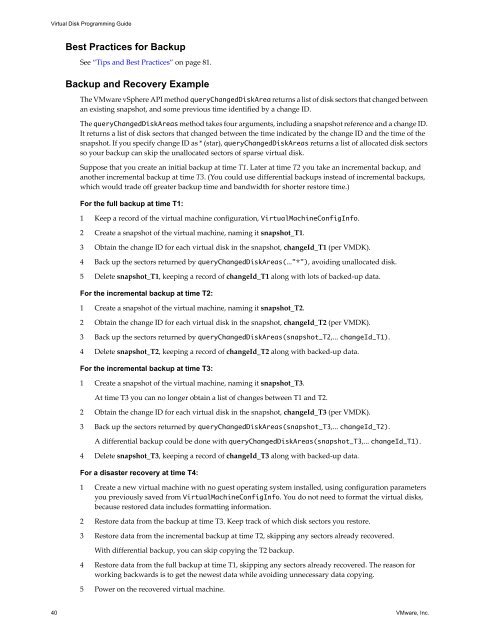Virtual Disk API Programming Guide - Documentation - VMware
Virtual Disk API Programming Guide - Documentation - VMware
Virtual Disk API Programming Guide - Documentation - VMware
Create successful ePaper yourself
Turn your PDF publications into a flip-book with our unique Google optimized e-Paper software.
<strong>Virtual</strong> <strong>Disk</strong> <strong>Programming</strong> <strong>Guide</strong><br />
Best Practices for Backup<br />
See “Tips and Best Practices” on page 81.<br />
Backup and Recovery Example<br />
The <strong>VMware</strong> vSphere <strong>API</strong> method queryChanged<strong>Disk</strong>Area returns a list of disk sectors that changed between<br />
an existing snapshot, and some previous time identified by a change ID.<br />
The queryChanged<strong>Disk</strong>Areas method takes four arguments, including a snapshot reference and a change ID.<br />
It returns a list of disk sectors that changed between the time indicated by the change ID and the time of the<br />
snapshot. If you specify change ID as * (star), queryChanged<strong>Disk</strong>Areas returns a list of allocated disk sectors<br />
so your backup can skip the unallocated sectors of sparse virtual disk.<br />
Suppose that you create an initial backup at time T1. Later at time T2 you take an incremental backup, and<br />
another incremental backup at time T3. (You could use differential backups instead of incremental backups,<br />
which would trade off greater backup time and bandwidth for shorter restore time.)<br />
For the full backup at time T1:<br />
1 Keep a record of the virtual machine configuration, <strong>Virtual</strong>MachineConfigInfo.<br />
2 Create a snapshot of the virtual machine, naming it snapshot_T1.<br />
3 Obtain the change ID for each virtual disk in the snapshot, changeId_T1 (per VMDK).<br />
4 Back up the sectors returned by queryChanged<strong>Disk</strong>Areas(..."*"), avoiding unallocated disk.<br />
5 Delete snapshot_T1, keeping a record of changeId_T1 along with lots of backed‐up data.<br />
For the incremental backup at time T2:<br />
1 Create a snapshot of the virtual machine, naming it snapshot_T2.<br />
2 Obtain the change ID for each virtual disk in the snapshot, changeId_T2 (per VMDK).<br />
3 Back up the sectors returned by queryChanged<strong>Disk</strong>Areas(snapshot_T2,... changeId_T1).<br />
4 Delete snapshot_T2, keeping a record of changeId_T2 along with backed‐up data.<br />
For the incremental backup at time T3:<br />
1 Create a snapshot of the virtual machine, naming it snapshot_T3.<br />
At time T3 you can no longer obtain a list of changes between T1 and T2.<br />
2 Obtain the change ID for each virtual disk in the snapshot, changeId_T3 (per VMDK).<br />
3 Back up the sectors returned by queryChanged<strong>Disk</strong>Areas(snapshot_T3,... changeId_T2).<br />
A differential backup could be done with queryChanged<strong>Disk</strong>Areas(snapshot_T3,... changeId_T1).<br />
4 Delete snapshot_T3, keeping a record of changeId_T3 along with backed‐up data.<br />
For a disaster recovery at time T4:<br />
1 Create a new virtual machine with no guest operating system installed, using configuration parameters<br />
you previously saved from <strong>Virtual</strong>MachineConfigInfo. You do not need to format the virtual disks,<br />
because restored data includes formatting information.<br />
2 Restore data from the backup at time T3. Keep track of which disk sectors you restore.<br />
3 Restore data from the incremental backup at time T2, skipping any sectors already recovered.<br />
With differential backup, you can skip copying the T2 backup.<br />
4 Restore data from the full backup at time T1, skipping any sectors already recovered. The reason for<br />
working backwards is to get the newest data while avoiding unnecessary data copying.<br />
5 Power on the recovered virtual machine.<br />
40 <strong>VMware</strong>, Inc.

















